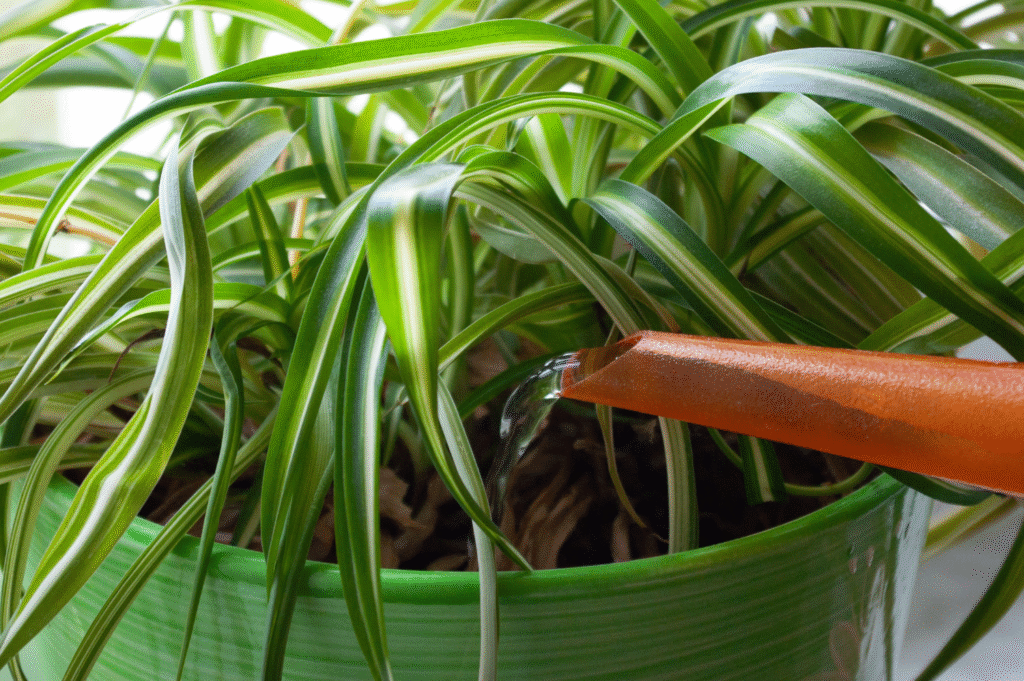Spider plants (Chlorophytum comosum) are among the most popular indoor houseplants and for good reason. They’re easy to grow, air-purifying, and resilient. But one of the most common questions plant owners ask is: how often should you water a spider plant?
In this detailed care guide, we’ll break down everything you need to know about spider plant watering frequency, seasonal tips, warning signs of overwatering or underwatering, and expert care practices. Whether you’re a beginner or a seasoned indoor gardener, this article will help you avoid watering mistakes and keep your spider plant thriving.
Understanding the Spider Plant’s Watering Needs
Spider plants are native to tropical and southern Africa, where they grow in partially shaded, well-drained environments. Indoors, they prefer a balance between moist and dry soil. Overwatering or underwatering can stress the plant and cause yellowing leaves, root rot, or stunted growth.
Key Takeaway:
Spider plants like their soil to dry out slightly between waterings (not bone dry, not soaking wet).
How Often Should You Water a Spider Plant?
1. Ideal Watering Frequency:
- Spring and Summer (active growing season):
Water once every 5 to 7 days when the top 1 inch of soil feels dry. - Fall and Winter (dormant season):
Water once every 10 to 14 days, or even less if the room is cool and humid.
2. Always Follow This Rule:
Feel the soil before watering. If the top inch is dry, it’s time to water. If it still feels moist, wait a few more days.
Factors That Affect Watering Frequency
No two homes are the same, and several environmental factors can influence how often your spider plant needs water:
1. Humidity Levels
Spider plants love moderate humidity. In dry indoor air (especially during winter heating), the soil dries out faster.
Pro tip: Mist the leaves occasionally or place a humidity tray nearby if your home is dry.
2. Temperature
Warmer rooms speed up evaporation, requiring more frequent watering. Cooler spaces slow it down.
3. Pot Type
- Terracotta pots dry out quicker.
- Plastic or glazed pots retain moisture longer.
4. Soil Type
Well-draining soil is essential. Use a mix that includes perlite or sand to prevent waterlogging.
5. Pot Size
Small pots dry out faster than larger ones. Adjust your watering based on the container size.
Signs You’re Overwatering or Underwatering
1. Overwatering:
- Yellowing leaves
- Wilting despite moist soil
- Root rot (brown, mushy roots)
- Mold or fungus on soil surface
2. Underwatering:
- Brown leaf tips
- Crispy or curling leaves
- Dry, compact soil
- Drooping plant with dry roots
Best Watering Practices for Spider Plants
Want to make sure you’re watering your spider plant the right way every time? Follow these tried-and-tested methods:
1. Use Room Temperature Water
Cold water can shock the roots. Let tap water sit for a few hours to allow chlorine to evaporate.
2. Water Thoroughly
Water until it drains from the bottom of the pot, but don’t let the plant sit in standing water.
3. Use the Finger Test
Insert your finger 1 inch into the soil. If it feels dry, water it. If moist, hold off.
4. Maintain Proper Drainage
Make sure your pot has a drainage hole. This prevents root rot and water buildup.
Should You Mist a Spider Plant?
Misting is optional but beneficial in dry environments. It helps increase humidity and keeps the leaves dust-free. However, misting alone won’t replace proper watering.
Seasonal Spider Plant Watering Tips
1. Spring/Summer:
- Faster growth = more water needs.
- Check soil every 4–5 days.
2. Fall/Winter:
- Growth slows down.
- Water less often, once every 10–14 days.
Extra Tips for Healthier Watering
- Fluoride-free water: Spider plants are sensitive to fluoride and salts in tap water. Use filtered or rainwater if possible.
- Avoid water on leaves: Pour water directly into the soil to prevent leaf spots.
- Trim brown tips: If watering is on point but the tips are still browning, it might be mineral buildup. Flush the soil once a month.
Frequently Asked Questions
Can I use ice cubes to water spider plants?
No. Ice can shock the roots and cause stress. Always use room temperature water.
How do I revive an overwatered spider plant?
Let the soil dry completely. Remove any mushy roots, repot in fresh, dry soil, and reduce your watering schedule.
Why are my spider plant’s tips turning brown?
Usually due to low humidity, overwatering, or fluoride in tap water. Check your watering routine and consider switching to filtered water.
Final Thoughts
Spider plants are low-maintenance, but their watering schedule needs some attention. By observing the soil, adjusting to seasons, and avoiding common watering mistakes, you can enjoy a lush, vibrant spider plant all year round.





